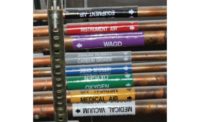Marginal water supplies present a particular challenge when consulting engineers performance-specify. Building, renovating or retrofitting with a fire pump requires the first cost of the pump, the pressure maintenance pump, controllers and a reliable or alternate source of electric power, diesel drive or steam drive.
Owning a fire pump also requires the cost of regular inspection, testing and maintenance (ITM). Therefore, the best time to find out whether a fire pump is necessary is early on in the design stage. The first costs of pumps and power need to be captured in the construction budget, the architect needs to provide a fire-rated pump room large enough to house pumps and controllers, and the owner needs to plan the cost of ITM into their operating budget.
Capturing the costs associated with a fire pump, if required, is imperative during design. Not capturing the costs associated with a fire pump, if one is not required, is equally important. Careful consideration of fire water supply and demand is necessary as early as possible during the design. When faced with an apparently marginal water supply, a consulting engineer may be inclined to figure conservatively and employ a fire pump. Because of budgetary ramifications, this type of conservative decision could ruin a client relationship if the builder’s calculations show during construction the pump was not necessary.
Understanding supply
In order to properly apply pumping to water-based fire suppression, recognizing the fire water supply is beyond the consulting engineer’s control, improve margin by minimizing pressure losses in the fire suppression system itself. Margin is the surplus water pressure when you subtract the demand pressure from the supply pressure at a particular operating point. Both pressures are normalized to a common location known as the base of riser (BOR) and compared graphically. Now consider both supply and demand pressures vary with flow and you may realize it is necessary to understand how much water flows to a design fire in order to identify the margin.
Flow is dependent upon how many fire sprinklers operate, where they are located relative to the BOR and the required hose stream. Vast collections of empirical data by reputable sources indicate the high majority of all fires are controlled with significantly fewer fire-sprinkler heads than are required to be in a minimum design area as defined in NFPA 13, FM Global (FM) or the Unified Facilities Criteria (UFC). This means compliance with a design standard requires a conservative demand flow compared to the actual flow likely to control a fire in the design area assuming the protected hazard has been properly identified.
A calculated design margin of zero would provide a positive margin if less than the quantity of fire-sprinkler heads in a given design area activate. Some standards dictate a minimum requirement for margin, but NFPA 13 does not. We are able to influence fire water demand flow through intentional application of the applicable design standard. NFPA 13 gives engineers and designers more latitude than FM and UFC standards.
A clear understanding of supply begins with a recent fire hydrant flow test in the vicinity of the project. Testing should be performed in accordance with NFPA 291 or a similar guideline. The difference between static and residual pressures needs to show a discernable pressure loss. Question the testing agency if fire hydrant test results are not clear. It is imperative that no assumptions are made about test results associated with the water supply. Fire hydrant flow tests provide a snapshot in time of fire water supply performance. It is necessary to have a high degree of confidence the results are repeatable because the above-ground fire-suppression design depends on this data.
Minimizing demand flow
Let’s consider ways to minimize pressure losses in a fire-suppression system in order to improve margin. Finding the minimum allowed demand flow to the hydraulically-remote area is the first order of business. Remember that physically remote is not necessarily hydraulically remote and several sets of hydraulic calculations may be necessary to approximate the design area with the highest demand.
Keep building height as short as possible. Building height is the single-largest consumer of available pressure and will almost certainly not be a consideration for the architect. If the building program requires a multistory building, you may be forced into a fire pump by height alone. If the project is just tall enough for the water supply to be considered marginal, can an attic level be avoided? Can an attic be made inaccessible and non-combustible in order to avoid sprinklering?
If the prevailing design standard allows, look for opportunities to omit fire sprinklers or apply a design-area reduction. It is crucial to understand all unique design requirements you are bound to by the design standard you are working with. Insurers and federal agencies often have requirements that actually increase water demand far beyond common NFPA 13 requirements.
Minimizing demand pressure
Once you are confident you have approximated the minimum design flow, it is time to look at minimizing friction losses. Increasing pipe diameter is one way to reduce friction losses. Another is employing a looped main or gridded system that gives water multiple pathways to reach a design fire. Sometimes this can be done without an increase in pipe size. If an isolated area in a facility has a significantly higher design density, such as the acetylene torch cutting area in the middle of a welding lab, consider routing the fire main directly toward the high-demand area from the riser first.
Of course, larger pipes and multiple pipes mean higher material and labor costs. It is important for the consulting engineer to develop the system far enough to have an understanding of size and route of fire-sprinkler risers and mains. Enough information must be conveyed on the drawings to ensure the builder can infer the design intent that was used to realize the anticipated friction losses. Early attempts at hydraulic design may have the builder asking for a fire pump. The ensuing conversation needs to be based in defensible design logic in order to bring resolution.
Underground piping between the utility tie-in and the building provides similar opportunities to reduce flow and pressure losses. It is vitally important to understand the configuration and sizes of the utility infrastructure in order to have a degree of confidence that the fire-flow test results are repeatable.
Backflow prevention is a requirement of the plumbing code to protect water supplies from cross-contamination. Many municipalities require outdoor backflow prevention near the tie-in. If your building is far enough from the existing underground water main to require adding a fire hydrant, be cautious about designing private fire hydrants on the building main downstream of the backflow preventer. Tie fire hydrants in upstream of the backflow preventer or tie into a different location on the city main. Additional friction loss through a backflow preventer due to hose stream will be substantial.
What is an acceptable margin? If working with NFPA 13, there is latitude for professional judgement. When deciding, it is necessary to consider aging of pipe over the anticipated lifespan, as well as the likelihood for future expansion or a change in the building program. Some design standards dictate as much as 10 psi or 10%. It is important to vet the question through the authority having jurisdiction during design in order to avoid surprising them with narrow margins during construction. It is much easier to debate the rationale for or against a fire pump with an AHJ during design. Margins in the low single digits are hydraulically viable but may be a difficult sell.
If through this process you have determined there is no way to achieve the required minimum margin without a fire pump, this method also will minimize the size of the fire pump. There is no green incentive for being conservative with fire-pump sizing and being too conservative has a higher first cost. If a standpipe system or combined system is required in your facility, consider employing a manual wet standpipe to separate standpipe demand from the fire-sprinkler system. This will greatly reduce the capacity of your pump and power sources.
Performance-based design of fire suppression requires far more effort than simply denoting an area of coverage on plan-view drawings and applying rule of thumb. Identify or choose a minimum margin you can confidently defend. Know the prevailing design standard inside and out. Apply it as required but take advantage of allowed exceptions. And finally, convey a clear plan for the builder to start with.



